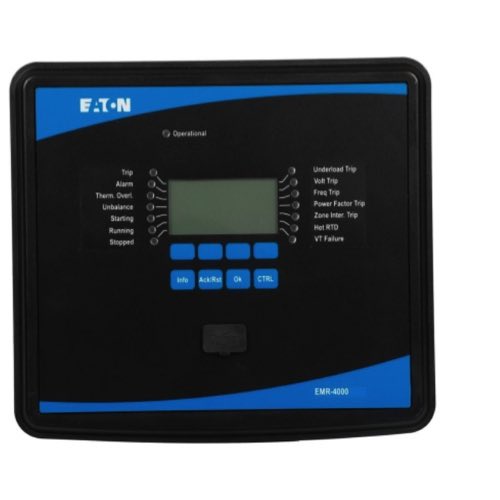Protection Relays

Protection relays are critical components in a power system, designed to detect abnormal conditions and initiate isolation of faulty sections to protect equipment and ensure system stability. Numerical relays, which have largely replaced older static relays, provide precise and adaptive control through microprocessor-based logic, allowing for multiple protective functions to be housed within a single device. These relays monitor critical parameters like current, voltage, frequency, and impedance to respond to a wide range of issues, including overcurrent, ground fault, and voltage protection. By identifying the fault point quickly, they help maintain power quality and reliability across both distribution protection and transmission lines.
In motor protection and pump protection applications, protection relays safeguard against conditions like overloads, locked rotors, phase imbalance, and ground faults. Feeder protection systems often incorporate distance relays and overcurrent relays to isolate faults and maintain service to unaffected parts of the system. Differential protection is another key function used for transformers, busbars, and motors, providing sensitive fault detection within a defined protected zone by comparing current entering and leaving the equipment. Most numerical relays also allow for relay location optimization and configuration flexibility, enabling better coordination and reduced response times in complex distribution networks.
More Information about Protection Relays
Modern digital protective relay systems often integrate communication protocols and remote access capabilities, allowing for centralized monitoring, real-time diagnostics, and simplified maintenance. Advanced relays are capable of replacing multiple protection devices and integrating programmable logic for automation, control, and interlocking. When used in high-reliability environments, such as substations with breaker failure protection schemes, these relays play a vital role in maintaining continuous operation of critical infrastructure. Additionally, features like digital inputs, precise voltage inputs, and rapid decision-making allow most numerical relays to deliver robust protection across a wide range of ac circuits and operating conditions.
FAQs
Can a circuit breaker provide backup protection against equipment damage in current transformers?
A circuit breaker alone cannot provide backup protection against equipment damage in current transformers; dedicated protection relays are required to detect faults and initiate breaker operation.
Can protection relays provide protection against arc flash events for critical equipment in control systems?
Yes, protection relays can provide protection against arc flash events for critical equipment in control systems by detecting high-speed faults and triggering circuit breakers to isolate the faulted section quickly, minimizing damage and enhancing personnel safety.
What is a Relay & How it Works
What is a relay?
A relay is an electrically operated switch. Most relays use an electromagnetic to operate the switch. An electromagnet is a device that creates a magnetic field by passing an electrical current through a coil of wire. The magnetic field is then turned off when the current is removed.
Why use relays?
Relays are commonly used when there is a need to control a switch with high voltage or circuits with large amounts of current passing through them. Operating these types of switches manually can be dangerous, inefficient and impractical. By using relays, operational safety is increased while also providing the ability to use smaller, safer and less expensive electrical equipment to control devices. Using relays allow for control of several devices on a single switch, as opposed to using several switches for each device. Relays can be combined with timers and logic circuits to assist in electrical automation.
How do relays work?
A relay consists of two separate circuits that work together to open or close a switch (or contacts). The first circuit drives the coil (or electromagnet). The electricity passes through the coil, creating a magnetic field. The second circuit contains a set contacts and a separate power source. This circuit is what provides power to the electrical load.
When electricity passes through the coil, it creates a magnetic field. This magnetic field pulls the contact from the other circuit closed (or against the stationary contact) which will allow current to pass through the contacts, therefore allowing the load to become energized. When the coil is de-energized, the magnetic field is gone which allows the contact to be pushed back into its original state, de-energizing the load side of the circuit.

